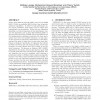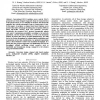64 search results - page 8 / 13 » Performance Analysis of the IEEE 802.11 MAC and Physical Lay... |
MSWIM
2004
ACM
14 years 2 months ago
2004
ACM
Today, three different physical (PHY) layers for the IEEE 802.11 WLAN are available (802.11a/b/g); they all provide multi-rate capabilities. To achieve a high performance under v...
INFOCOM
2005
IEEE
14 years 2 months ago
2005
IEEE
—It is well known that IEEE 802.11 provides a physical layer multirate capability and, hence, MAC layer mechanisms are needed to exploit this capability. Several solutions have b...
WOWMOM
2005
ACM
14 years 2 months ago
2005
ACM
WLAN technology has been shown a revolutionary development during the last decade. Recently popularized IEEE 802.11a/gbased products can support up to 54 Mbps PHY (Physical layer)...
INFOCOM
2009
IEEE
14 years 3 months ago
2009
IEEE
Abstract—This paper presents a protocol-independent approach to reveal a new insight into the performance of carrier sense multiple access with collision avoidance (CSMA/CA) prot...
ICC
2007
IEEE
14 years 3 months ago
2007
IEEE
—Conventional 802.11 medium access control (MAC) characteristics. In particular, all of these designs adopted a protocols have been designed separately from the characteristics s...


